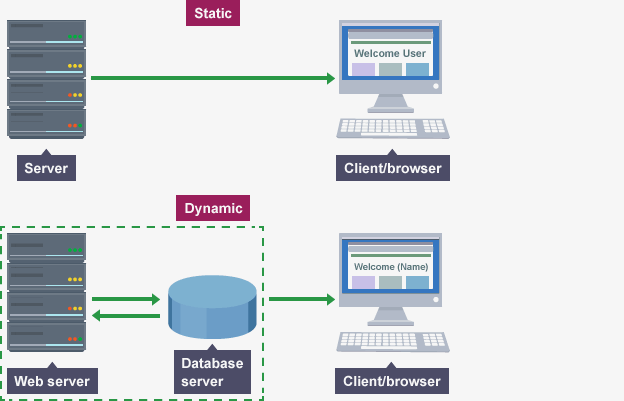You can very easily differentiate between static and a dynamic website. If the look of the web age is more basic, is for some small company, and delivers information in a very simple and down-to-earth manner, and then you are looking at a static page. Static webpages are cheaper to develop in comparison to the dynamic web pages and provide only for the basic web presence.
The content of the static web pages cannot be changed without a web-developer actually editing and changing the source code. The dynamic websites and web pages can display many different kinds of content that have origins in the same source code.
You may think the source code is the most important part creating and developing a business friendly website. This is not always true. The more important thing is the purpose that each page is serving. A dynamic webpage serves a range of business functions, and almost all modern and new business websites today are dynamic in nature.

Static Web Pages
A static web page displays the same content, images and videos to any visitor who visits the website once or repeatedly. If you want to change the content, then you have to use the source code of the page for doing so.
Advantages of the static web pages and websites
- Can be developed rather easily
- Are less costly to develop
- Are also quite cheap to host
Disadvantages of the static web pages and the websites
- A good web-development expertise is required for updating the static web-pages
- Site may not be very highly useful for the visitors and users
- May suffer from content stagnation
Dynamic Website
A dynamic website can produce many different kinds of content, and these are designed for the different website visitors. The content can be classified and displayed; on the basis of the user‘s device, like whether it is a smartphone or a PC; on the basis of the operating system of the system (Windows or Mac) or the basis of the web browser that the visitor has. Sometimes the content also depends on the source from where the visitor has been actually referred to the dynamic web page.
Dynamic websites require more money for their development. They give the site owner the ability and authority to update the website and add new content to it anytime he/she wishes. A simple browser interface provides for the addition of new news and other content like blogs and articles and keeps the dynamic web pages fresh. The examples of dynamic web pages are the e-commerce systems; CMS or Content Management Systems; discussion and bulletin boards; extranet and intranet facilities; websites that give the upload facility to the users and clients, and; the websites that give ability to the administrators for creating new content, editing the old ones and addition of information.
As we can see, there is a huge versatility added to the dynamic web pages. The websites are run by the CMS or the Content Management Systems. Through the CMS, a singular source-code file can also load the same content to different pages. Content creators also use the gateway pages to submit new content and other materials for the new pages. The database is hence used by the dynamic pages, and they get the required materials for any page, through it. The pages are loaded on the basis of URL parameters that are requested by the visitor/user. Users can also log in to view the personalized pages, which are also the dynamic pages.
Advantages of dynamic web pages and websites
- Much more functionality
- Easy to update
- Always a fresh site the brings in new visitors or/and prospective customers
- A system that provides for unique collaboration of the admin., staff and the visitors/users
Disadvantages of the dynamic web pages and websites
- More expensive
- Require time for development
- Higher hosting costs
Language Used for the static and the dynamic websites
While JavaScript, PHP and Action script are some the languages used for creating the dynamic web pages, the static web pages are often created by using the HTML language. Dynamic pages also use the Flex, Django and Ruby on Rails for their frameworks. The dynamic frameworks and languages have the requisite technological capacity for creating the static webpage as well. However the static pages created this way can be more complex in their structure, and can also be more difficult to maintain.
Most sites created in the earlier decade were static. Dynamic websites are the modern next generation websites. They offer many more features and benefits to both the site admin and the visitors/users. Businesses can get the most from the dynamic websites as they have a number of tools that provide for professional satisfaction and growth.

